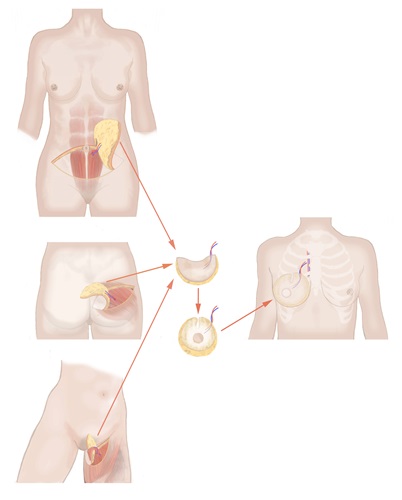This Method uses skin, fat and in some instances, muscle from another part of the body to create a breast. Own Tissue Reconstruction is also known as autologous reconstruction. Tissue can be moved either as a Pedicled Flap to the breast, or as a Free Flap. These procedures provide a very different method for breast reconstruction (as opposed to an implant) and tissue can be taken from the tummy, thighs, buttock or back – it depends entirely on body shape. If the patient is very thin, an autologous reconstruction from the thigh or buttock might be the best or only option.

Advantages?
- Own tissue reconstruction usually results in a more natural breast appearance, especially when matching a single breast to the unaffected side. This is because free tissue transplant follows the normal evolution of ageing, in comparison to an implant-based reconstruction, which has a less ‘flexible’ fit and more sculpted appearance. This in mind, it’s true to say that flap procedures behave more in tune with your own body – ageing and gaining/losing weight as you do.
- Own tissue only has to be moved just once. Implants do not last a lifetime (and risk rupture) and therefore will need further replacement surgery at some point.
- Additionally, radiotherapy doesn\’t have any major adverse effect on the outcome of the reconstruction, therefore avoiding any foreign-body reaction like capsular contracture (excessive or invasive scar tissue formation), which can happen more frequently with an implant-based reconstruction.
Disadvantages?
- Taking tissue from another body part creates additional scars, which are not necessary in an implant-only reconstruction. In this case there’ll be two sets of scars – at the donor site and at the newly reconstructed breast, although all fade with time.
- The actual operation is more complex and takes longer. Therefore the procedure, hospital stay and recovery period are longer.
- Problems can occur at the donor sites, such as abdominal hernia, leg pain/stiffness, muscle pain or weakness. Own tissue surgery is not ideal for everyone as it depends on healthy blood vessels. Therefore, women that are smokers, or those with diabetes, weight or blood circulation issues, may not be offered the option.
- There may also be a loss of sensation around the donor site.
Which areas of the body can be used?
There are now a number of options available with regards to the donor areas for an autologous breast reconstruction. These range from the lower abdomen (tummy), buttocks, the back and the inner thigh. The donor site will be specifically selected depending on three things: your physical state, the volume of tissue required to reconstruct a new breast and your own personal preference.
This diagram shows the various options available with Own Tissue reconstruction.

The acronyms at the bottom of this diagram stand for the different operations that involve using your own tissue for breast reconstruction.
Own Tissue Reconstruction – An Outline
Operation Time:
Normally between 4 and 8 hours, depending on the complexity of the surgery. For example, free flaps involve microsurgery to reconnect the blood supply. If a mastectomy is being performed at the same time, the operation will be longer again.
Hospital Stay:
Type of Anaesthesia:
General anaesthetic
Recovery Time:
At least 6 weeks, possibly over 8
Risks of Surgery Include:
Bruising and swelling. Scarring.
Less common problems include infection, haematoma and seroma (swelling around a wound area where blood/body fluid has collected); lymphedema (when the lymph nodes are cleared); loss of the skin flap that’s been used for the reconstruction; blood transfusion (possible); weakness in the area used for the flap; aches and pains, particularly if an LD Flap (latissimus dorsi from the back) has been used.
Abdominal hernia (after a stomach Tram Flap or Free Tram Flap). This is quite rare, but can happen due to the weakening of the abdominal wall.
Further Treatment:
Visit to the Hospital Dressing Clinic (a week after discharge).
Check up with your surgeon/registrar
Nipple Reconstruction:
Around 3 months later
Nipple Tattooing:
1 month after reconstruction (by your surgical team